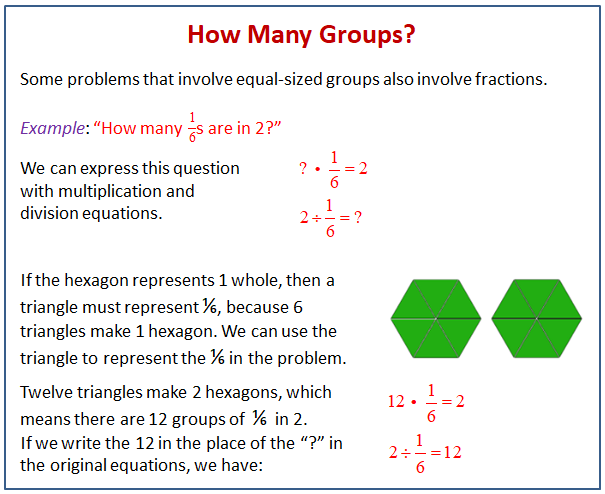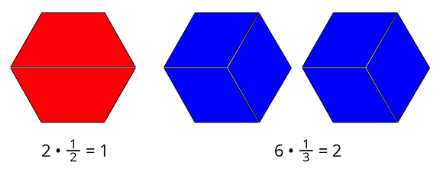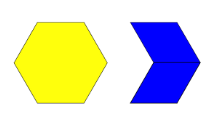Illustrative Mathematics Unit 6.4, Lesson 4: How Many Groups? (Part 1)
Learning Targets:
- I can find how many groups there are when the amount in each group is not a whole number.
- I can use diagrams and multiplication and division equations to represent “how many groups?” questions.
Related Pages
Illustrative Math
Grade 6
Lesson 4: How Many Groups? (Part 1)
Let’s play with blocks and diagrams to think about division with fractions.
Illustrative Math Unit 6.4, Lesson 4 (printable worksheets)
Lesson 4 Summary
The following diagram shows how to solve problems that involve equal-sized groups that also involve fractions.

Lesson 4.1 Equal-sized Groups
Write a multiplication equation and a division equation for each statement or diagram.
- Eight $5 bills are worth $40.
- There are 9 thirds in 3 ones.
3.
Lesson 4.2 Reasoning with Pattern Blocks
Use the pattern blocks in the applet to answer the questions. (If you need help aligning the pieces, you can turn on the grid.)
Show Applet
- If a hexagon represents 1 whole, what fraction do each of the following shapes represent? Be prepared to show or explain your reasoning.
a. 1 triangle
b. 1 rhombus
c. 1 trapezoid
d. 4 triangles
e. 3 rhombuses
f. 2 hexagons
g. 1 hexagon and 1 trapezoid - Here are Elena’s diagrams for 2 · ½ and 6 · ⅓ = 2. Do you think these diagrams represent the equations? Explain or show your reasoning.
- Use pattern blocks to represent each multiplication equation. Recall that a hexagon represents 1 whole.
a. 3 · ⅙ = ½
b. 2 · 3/2 = 3 - Answer the following questions. If you get stuck, use pattern blocks.
a. How many ½s are in 4?
b. How many ⅔s are in 2?
c. How many ⅕s are in 1½?
Lesson 4 Practice Problems
- A shopper buys cat food in bags of 3 lbs. Her cat eats ¾lb each week. How many weeks does one bag last?
a. Draw a diagram to represent the situation and label your diagram so it can be followed by others. Answer the question.
b. Write a multiplication or division equation to represent the situation.
c. Multiply your answer in the first question (the number of weeks) by ¾. Did you get 3 as a result? If not, revise your previous work. - Use the diagram to answer the question: How many ⅓s are in 1⅔? The hexagon represents 1 whole. Explain or show your reasoning.
- Which question can be represented by the equation ? · ⅛ = 3?
A. How many 3s are in ⅛?
B. What is 3 groups of ⅛?
C. How many ⅛s are in 3?
d. What is ⅛ of 3? - Write two division equations for each multiplication equation.
a. 15 · ⅖ = 6
b. 6 · 4/3 = 8
c. 16 · ⅞ = 14 - Noah and his friends are going to an amusement park. The total cost of admission for 8 students is $100, and all students share the cost equally. Noah brought $13 for his ticket. Did he bring enough money to get into the park? Explain your reasoning.
- Write a division expression with a quotient that is:
a. greater than 8 ÷ 0.0001
b. less than 8 ÷ 0.0001
c. between 8 ÷ 0.0001 and 8 ÷ 1/10 - Find each unknown number.
a. 12 is 150% of what number?
b. 5 is 50% of what number?
c. 10% of what number is 300?
d. 5% of what number is 72?
e. 20 is 80% of what number?
The Open Up Resources math curriculum is free to download from the Open Up Resources website and is also available from Illustrative Mathematics.
Try out our new and fun Fraction Concoction Game.
Add and subtract fractions to make exciting fraction concoctions following a recipe. There are four levels of difficulty: Easy, medium, hard and insane. Practice the basics of fraction addition and subtraction or challenge yourself with the insane level.

We welcome your feedback, comments and questions about this site or page. Please submit your feedback or enquiries via our Feedback page.


